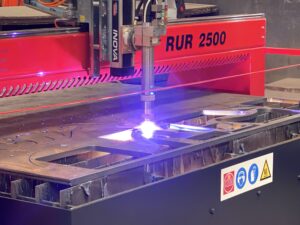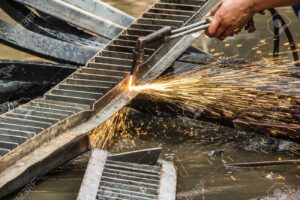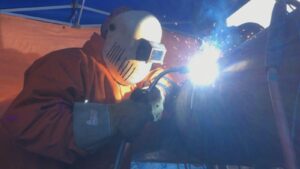Cutting methods used in industry
In industry, the key technological process is welding and thermal cutting of various metals and alloys, used in the course of production in industries such as construction, electrical engineering, metal, metallurgy and shipbuilding. These methods differ in the amount of energy used, speed, amount of material loss or the quality of the cut edges.
What is electric arc cutting?
It consists in melting or burning the gap with the heat of an electric arc between the electrode and the material being cut. This method includes plasma cutting and oxy-acetylene torch cutting, but this group also includes cutting:
arc-oxygen - obtained by fusing metal with the heat of an electric arc and burning oxygen. The cutting process is carried out with the use of a coated electrode MMA (Manual Arc Welding), it uses an electrode with a metal core covered with a compressed coating. Oxygen is applied through the center of the electrode, and the fluxes made of the mentioned coating stabilize the arc.
arc coated electrode - a low-carbon electrode wrapped in its heat melts the metal in the cutting gap. Direct current is then used. Due to the low quality of the edges, this method is mainly used for non-ferrous metals, e.g. in scrap yards.
Plasma cutting
Before we move on to plasma cutting, it is important to briefly explain what it actually is. It is often called the fourth stage  matter because ionized matter resembles gas. Plasma conducts electricity, but as the temperature rises, its resistance decreases - unlike metals. The melting of the metal causes the high temperature of the plasma arc to cut through the workpiece, and a high velocity gas stream removes the molten material from the bottom of the cut.
matter because ionized matter resembles gas. Plasma conducts electricity, but as the temperature rises, its resistance decreases - unlike metals. The melting of the metal causes the high temperature of the plasma arc to cut through the workpiece, and a high velocity gas stream removes the molten material from the bottom of the cut.
The cutting process begins as soon as the torch is set in motion. The most common plasma-forming gas is air. Gases such as argon, nitrogen, hydrogen, carbon dioxide or individual mixtures are used in devices with high power. Plasma can cut materials that conduct electricity, e.g. carbon steel, aluminum alloy, brass, copper or cast iron.
The advantages of plasma cutting include:
- cutting speed
- fast piercing and no need for heating
- very little thermal deformation
- small cutting gap and high surface quality
Plasma welding, unfortunately, has its disadvantages, which include:
- strong UV radiation
- emitting large amounts of gases and noxious fumes
- noise
- changes in the cutting zone
How does an oxygen-acetylene burner work?
 Oxy-acetylene (oxyacetylene) burners allow you to perform a wide range of works. It mixes two gases, and with the use of a suitable burner and nozzle, it produces a flame in excess of 3000 ° C. Oxy-acetylene torch can be used for welding and soldering. Due to its versatility, it is suitable for materials such as lead, aluminum, silver, tin, steel, copper and zinc. Cutting with this method allows you to split steel with a thickness of up to 300mm. The advantages of oxy-acetylene cutting include:
Oxy-acetylene (oxyacetylene) burners allow you to perform a wide range of works. It mixes two gases, and with the use of a suitable burner and nozzle, it produces a flame in excess of 3000 ° C. Oxy-acetylene torch can be used for welding and soldering. Due to its versatility, it is suitable for materials such as lead, aluminum, silver, tin, steel, copper and zinc. Cutting with this method allows you to split steel with a thickness of up to 300mm. The advantages of oxy-acetylene cutting include:
- wide range of cutting thicknesses
- high-quality cutting of thick materials
- possibility of cutting at different angles
The large area of the cut zone of the oxyacetylene torch also has its disadvantages:
- wide heat affected zone
- long pierce time through the material
- low working speed
- high-alloy steels and steels with high carbon content cannot be cut
Which welding method to choose?
The key to success is to adapt the parameters and methods to the specific case and alloy to be processed. You should consider what we care about the most - precision, tightness, speed of execution or costs.


































